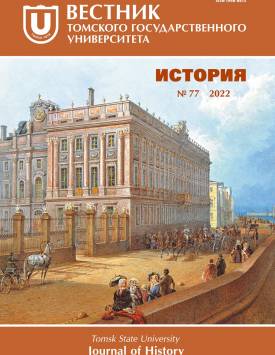To the problem of objective preconditions of siberian separatism
The article provides an overview of the main links in the history of Siberian separatism, as well as its vitality and the limitations of real political results. The main cases of irreversible disintegration of states in the last 300-400 years are considered, and a generalization is made that the separating part of a country is always isolated by the ethnic composition of the majority of the population, or / and by a spatial gap. The historical background of the collapse of the country is often caused by its foreign policy defeat, but this condition is not necessary (the collapse of European colonial empires). In the 1990s, the ideas to reduce the importance of the state as a social institution, as well as the transfer of part of its functions to the intra-state and regional level were popular. Regionalism and separatism are not the same thing, but regionalist sentiments (at the level of the macro-region) may favor separatist sentiments. Siberia being a macro-region, is not isolated from the rest of Russia in this relationship, and its separation seems extremely unlikely. The concept of “subethnos” is considered, and it is noted that in some cases the differences between subethnos of one ethnos are minimal, in some cases they are relatively large, up to approaching the level of interethnic differences (and then they can turn into a significant factor of macro-regional isolation). Differences in the Russian population of the macroregions of Russia are among the weakest differences in the sub-ethnic series. Siberia is not the most separate macro-region of Russia, either in the sub-ethnic or in the physical-geographical sense. In Siberia there is a separation factor, to some extent similar to a spatial gap - a considerable distance from the socio-economic and political core of the country. Another factor contributing to the existence of Siberian separatism is the socioeconomic lag of most of Eastern Siberia from other macro-regions of the country. Apart from the influence of socio-economic difficulties on the protest potential there is a territorial-organizational aspect. In Russia two developed areas (Western and Far Eastern) might be formed and separated by the lagging regions located in Eastern Siberia and the continental part of the Far East. Such a territorial structure of distribution of development levels, in addition to other obvious shortcomings, can contribute to the isolation (up to the intensification of separatist tendencies) of the marine part of the Far East, taking into account its involvement in economic relations with powerful neighboring states. The authors declare no conflicts of interests.
Keywords
separatism, Siberia, macro-region, ethnic composition, territorial gapAuthors
| Name | Organization | |
| Popov Petr L. | V.B. Sochava Institute of Geography SB RAS | plp@irigs.irk.ru |
| Cherenev Aleksei A. | V.B. Sochava Institute of Geography SB RAS | tcherenev@irigs.irk.ru |
References

To the problem of objective preconditions of siberian separatism | Tomsk State University Journal of History. 2022. № 77. DOI: 10.17223/19988613/77/6
